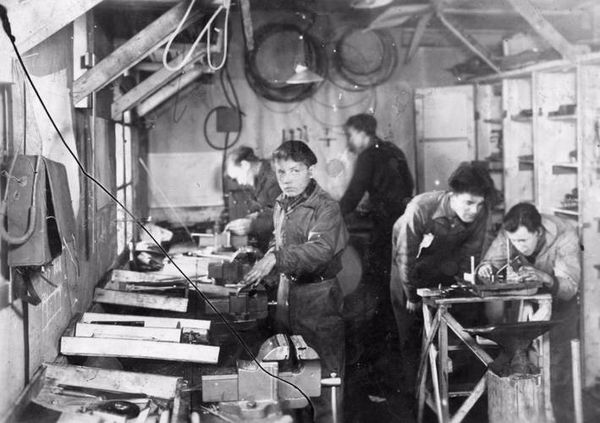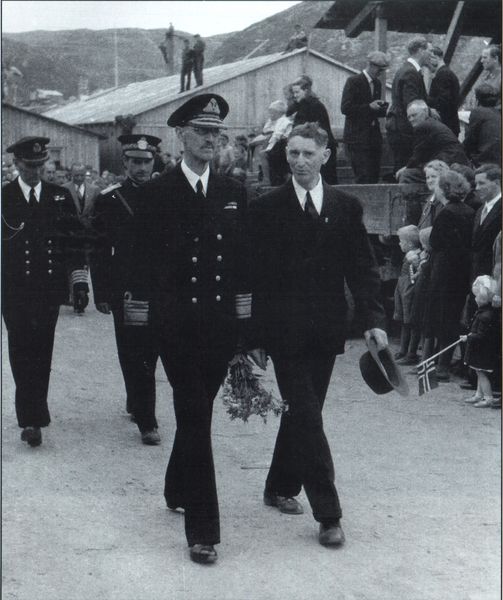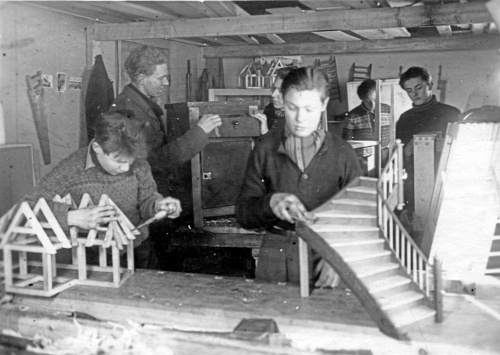 På norsk
På norsk  Sámegillii
Sámegillii
Article in the book Sami school history 3. Davvi Girji 2008.
 Chris Nickalls instructing his pupils in the mechanical workshop. |
The Englishman Chris Nickalls (1924–1992) was one of them who joined Fredsvennenes hjelpetjeneste to contribute to rebuilding of Finnmark after the war. He was educated in a quakers' school in York in England, and was active in the organisation "Friends' Ambulance Unit". Nickalls came to Kvalsund in June 1946 and should originally only stay for a few months, but ended up with taking responsibility for education inn mechanics, when it started in the autumn. Later he returned to England, where he got education as an engineer and worked mainly with water distribution and cleaning. This is a part of memories which he wrote in the 1970-s, and it starts just before the vocational course started. The article is edited by Inez Boon. |
An activity I became involved in and very much enjoyed was the receiving and unpacking of numerous boxes of splendid Swedish carpentry and other tools besides camping and kitchen equipment. These tools were made up into kits and accompanied the various work parties as they were formed and dispatched to other parts of Finnmark.
One day during this period was taken as a holiday and many of us went to Hammerfest on the occasion of the visit of His Majesty King Haakon VI aboard the royal yacht “Norge”. The air of festivity produced by this ship, dressed overall, with its band playing on the quay, and a Royal progress through the streets of the town, then very much in the process of rebuilding, are unforgettable memories. I perceived at this time that “patriotism” which in a 1930’s and war-time environment I had equated with militarism and imperialism could be something else as well. …………

|
King Haakon 7 visiting Hammerfest 10.07.1946. On the kongs left side mayor Toralf Albrigtsen, behind the king local chief of police Arvid Dahl. (Photo: Alf E. Jacobsen, Kilde: Hammerfest historielags kalender 1996) |
As the year progressed and daylight hours shortened, the various construction groups returned to Kvalsund as their projects terminated and parties left for the south. But FHT was not to be a purely summertime enterprise. As the [camp] population of the largest barrack fell, it was converted to use as a school building with workshops for carpentry and metal work and a domestic science room.
At this point I decided to prolong my stay in Norway by a further period until the spring as I was asked to be an instructor for the metal work class (4 or 5 boys) at the technical school which was to be set up for the winter season. As this involved further equipment buying I made a journey south to Oslo for this purpose. Whilst there I was given a conducted tour round one of the State Technical Schools to see how such things were done in Norway, and given some suitable textbooks. Several fascinating visits to Oslo’s biggest toolshop, Ingvald Nielsen, were required to order and get packed the equipment needed for the metalwork class.
Herr Skogen of Nielsens was especially helpful in assisting in the selection of the tools required. During this period in Oslo I was honoured to be the guest of Marit Nansen’s family who lived at Lysaker in a most memorable house built in a delightful woodland setting by Marit’s grandfather, Fridtjof Nansen, the polar explorer. [1]
 |
From the carpenters' course
(Photo: Fredsvennenes hjelpetjeneste) (In the printed version of the book Samisk skolehistorie 3 there in unfortunately a wrong picture. Here you see the right picture, the picture on page 292 of the book is not from Kvalsund, but from Øytun folk high school. We are sorry for the mistake.) |
My class started as five. The eldest pupil, Ole Hætta of about my age, was a Lapp from Kautokeino, whose grandfather had been responsible for the expulsion of a Christian missionary. [2] Other pupils were Charles Henriksen from Sørøy (17), Johannes Pedersen, another boy whose name I have forgotten [3] (he had a sister called Randi in the domestic science Class) from Mehamn, and a fifth boy who unfortunately dropped out after a few weeks.
Our workshop was equipped with a small electric lathe, supplied from Sweden, and this was the focal point of our technical resources. Owing to the other demands for electricity during the 24 hour nights the lathe could only be used after the evening meal. (The supply was generated by a water turbine in the hills some distance away, and there had been insufficient time for Herr Pedersen, the local magnate, to install his transformers before winter set in and the high voltage step up and step down system which had been planned, had to wait until the following year.)
The metalwork activities included forge-work, sheet-metalwork, soldering and brazing, filing, fitting and thread-cutting. High-spot for Charles was when a relative of his, who was proprietor of a fishing smack, found himself at Kvalsund with his engine out of action due to a run big-end bearing. With a little improvisation we were able to re-cast the white metal, machine the bearing in the lathe and get the engine going in about two days.
We were so busy running classes and our own existence, but I remember some extra-mural activities which includes a cross country ski-run after the sun came back on February 8th, and a party at the Pedersen’s house, where there was a piano which I was allowed to play …!
After a very happy term with a suitable celebration to conclude it, the school broke up, I think in time to allow pupils to travel home for Easter. Most of the tools were given to the boys completing the course, and packing cases were made for transporting them home. Some of the tools for the fifth pupil (who dropped out) were bought by me from FHT with my saved one krone per day pocket money, and I have and use them still.
[1]
[2]
[3]
More articles from Sami School History 3 - In Norwegian